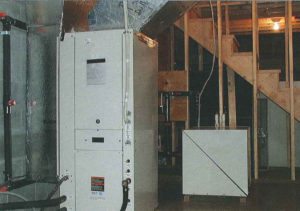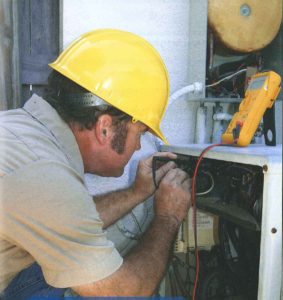Heating & Cooling
 If your heating and cooling system is 15 to 20 years old and is experiencing problems, it may be time to consider installing a new, efficient Energy Star® system.
If your heating and cooling system is 15 to 20 years old and is experiencing problems, it may be time to consider installing a new, efficient Energy Star® system.
If you are considering replacing the heating ventilating and air conditioning (HVAC) system that heats and cools your home, you need the right information to make an informed decision. Here are a list of questions to ask – things to consider – before purchasing your new HVAC system. By asking the right questions, you will be able to select the HVAC system that best fits your needs. Remember, that the best value may not necessarily come from the contractor that offers the lowest price. Click here for a printable brochure of this information.
SHOULD I REPLACE ALL OF MY HVAC EQUIPMENT AT THE SAME TIME?
Yes. You want to be sure that all the parts of your HVAC system work together properly. Replacing only the outdoor unit or the indoor unit of an HVAC system may appear to save money, but it could contribute to service problems later on.
A mismatched system may not deliver the energy efficiency or performance that you expect. If an older part of the system – such as an outdoor unit of a heat pump, ductwork, piping or a furnace – is replaced, it’s important to match the new part as closely as possible to the existing system.
Installing a new high-efficiency heat pump, for example, but using the old ductwork could affect performance. That ductwork may be leaky, restricted or inadequate – and may not be sized for your new heat pump. Ask your contractor to thoroughly inspect your ductwork to identify any problems. Ductwork should be properly sealed and insulated, and it should be sized for your new system.
WHAT SIZE DO I NEED?
An HVAC system that is too small cannot deliver adequate heating or cooling in extreme weather. And a system that is too large will not only cost more, but provide poorer temperature and humidity control.
To ensure that your new HVAC system is the right size for your home, ask a contractor to perform a detailed load calculation. This calculation determines the capacity of the equipment needed and the correct distribution of air to each room.
WHAT’S MY HOUSE GOT TO DO WITH IT?
Before you decide on an HVAC unit, look at making energy improvements to your home. Tuning up the home not only reduces operating costs but can mean a smaller, less expensive HVAC system can do the job. For more information on ways to improve your home’s energy efficiency, visit TogetherWeSave.com.
 WHAT TYPE OF SYSTEM SHOULD I BUY?
WHAT TYPE OF SYSTEM SHOULD I BUY?
You have many choices when it comes to selecting an HVAC system. Here are some things to consider:
- An electric split-system heat pump is a common choice for year-round heating and cooling. Other options include a heat pump with a backup boiler or furnace in colder climates, such as ours.
- The efficiency of a cooling system is expressed as a SEER (Seasonal Energy Efficiency Ratio) number. All cooling systems sold today must have at least a SEER 13 rating.
- Heat pump efficiency is expressed by a Heating Season Performance Factor (HPSF), and all heat pumps sold today must have an HSPF of at least 7.7.
- Systems with higher SEERs and HSPFs cost more initially, but have lower operating costs. Split-system heat pumps with an Energy Star® label have SEERs of 14.5 or higher and HSPFs of 8.2 or higher.
HOW DO I SELECT A CONTRACTOR TO DO THE WORK?
Selecting the right contractor is critical to the performance of your new HVAC system. The contractor is responsible for determining the type and size of system and explaining your options as well as installing the system. A good contractor also should provide a warranty and after-sale service.
Here are some tips on identifying the right contractor for the job:
- Ask about the licensing and qualification of prospective contractors. Is the contractor state-licensed? Is the contractor a member of state and national contractor associations such as Air Condition Contrators of America (ACCA)? Is the contractor adequately insured?
- Make sure that the contractor inpects your home and your existing system, and explains your options.
- Ask the contractor for the estimated annual operating costs of HVAC systems with different efficiencies (SEERs and HSPFs). This information will help you determine the total cost of each system over the lifetime of the unit.
- Make sure the contractor has adequate staff to install the system and respond promptly to service calls. What guarantees, warranties and follow-up service are offered? Warranties vary, so it’s very important to know what is inclued in the warranty and what is not. Ask about a maintenance service agreement – what does it cost and what does it cover?
- Are the technicians NATE (North American Technician Excellence) certified? Are they familiar with the brand of equipment that you want to buy? Will they perform load calcualtions, duct design and intallation using industry-standard methods?
- Get three written estimates for the work: what is being done, what equipment is being provided and when installation will begin and be completed. Understand what is included in each price. Remember that the best value many not necessarily come from the contractor that offers the lowest price. Consider the cost of operating the system as well as the initial cost.
 MAINTENANCE
MAINTENANCE
Even the best installed, most efficient equipment requires routine maintenance.
Here are a few things YOU can do to maintain your HVAC system:
- Inspect the air filter and replace it at least four times a year.
- Check the thermostat setting. A good starting point is 78°F in the summer and 68°F in the winter. A programmable thermostat can save more by letting the home’s temperature rise in the summmer or fall in the winter by a few degrees when the house is unoccupied.
- Make sure the supply and return vents are open and not blocked by furniture.
- Keep you outdoor unit clean and make sure nothing blocks air flow to it.
Here are maintenance points a LICENSED TECHNICIAN can do:
- Tighten all electrical connections.
- Lubricate all moving parts.
- Inspect the air conditioner’s condensate drain.
- Check system’s controls for wear or damage.
- Check system’s refrigerant charge.
- Inspect ductwork for leaks.
- Adjust blower to provide proper airflow.
GLOSSARY
ACCA: Air Conditioning Contractors of America – the nationwide association representing the HVAC contracting industy.
ARI: Air Conditioning and Refrigeration Institute, which publishes a directory of unitary equipment at ahridirectory.org.
HSPF: Heating Seasonal Performance Factor is a measure of heat pump’s energy efficiency over one heating season. It represents the total heating output of a heat pump (including supplementary electric heat) during the normal heating season (in Btu) as compared to the total electricity consumed (in watt-hours) during the same period.
NATE: North American Technician Excellence, Inc. is the leading certification program for technicians in the heating, ventilation, air-conditioning, and refrigeration (HVAC/R) industry. It conducts the only test supported by the entire industry. HVAC technicians certified by NATE pass stringent exams covering their certification specialty.
SEER: Seasonal Energy Efficiency Ratio is a measure of equipment energy efficiency over the cooling season. It represents the total cooling of a central air conditioner or heat pump (in Btu) during the normal cooling season as compared to the total electric energy input (in watt-hours) consumed during the same period.
SPLIT SYSTEM: A typical residential HVAC system consisting of an indoor blower and coil connected by refrigerant lines to and outdoor unit housing a compressor, fan , and coil.
